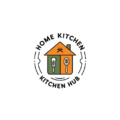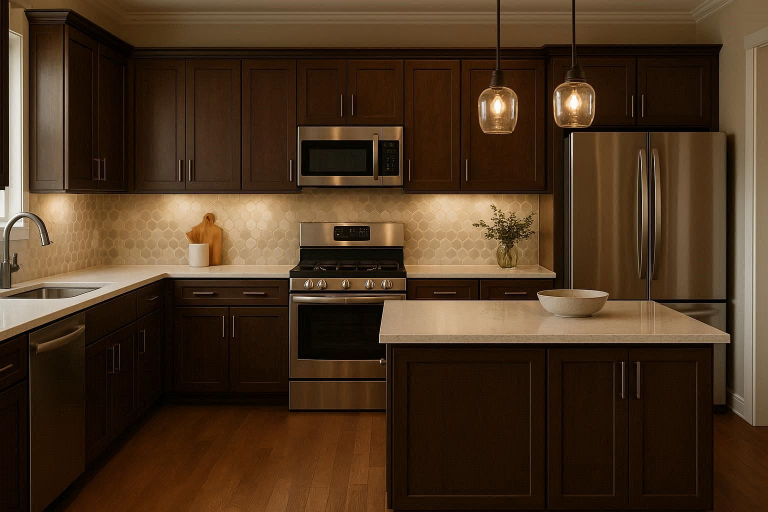When designing or renovating your kitchen, one of the most crucial aspects to consider is the height of your kitchen counters. Whether you’re an avid home cook or someone who enjoys a stylish, functional kitchen, the right counter height can make all the difference in terms of comfort and efficiency.
In this blog post, we’ll explore the standard kitchen counter height, its variations across different regions and kitchen types, and how to choose the right height for your space. We’ll also discuss how ergonomics and design preferences can influence your decision.
Understanding the Importance of Kitchen Counter Height
Comfort and Ergonomics
The right kitchen counter height is essential for comfort and ergonomics. If your kitchen counters are too high or too low, you may experience back and wrist strain while preparing meals, washing dishes, or performing other tasks. For example, if the counter is too high, you may need to raise your arms uncomfortably, leading to shoulder strain. On the other hand, if the counter is too low, you may Kitchen Appliances for Small Homes have to bend over excessively, resulting in back pain over time.
Proper counter height helps reduce fatigue and makes your kitchen more comfortable to work in. This is particularly important for people who spend long hours cooking or cleaning. By choosing the right counter height, you can make your kitchen more enjoyable and reduce the physical strain often associated with everyday tasks.
Kitchen Design and Aesthetics
Counter height also plays a significant role in your kitchen’s overall design and aesthetic appeal. The height of your counters can affect how spacious your kitchen feels and how well it integrates with the rest of your home. For instance, a taller countertop can give your kitchen a more modern, sleek look, while lower counters can contribute to a more cozy, traditional feel.
In open-concept kitchens, counter height becomes an even more prominent design element. The right height can help differentiate cooking areas from dining or entertaining spaces, making your kitchen both functional and visually appealing.
What is the Standard Kitchen Counter Height?
Typical Standard Height
The typical standard height for kitchen counters is 36 inches (91 cm). This height is considered ideal for most people because it is comfortable for preparing food, cooking, and cleaning. A counter at this height allows you to work with your arms at a natural angle and minimizes strain on your back and wrists.
A 36-inch height is commonly used in both residential and commercial kitchens because it strikes a balance between comfort, functionality, and aesthetics. This height is suitable for individuals of average height (around 5’5” to 5’10”) and is the standard for most kitchen designs.
Variations in Standard Kitchen Counter Heights
While 36 inches is the standard for most kitchens, there are variations depending on the country, region, or specific design choices.
- International Differences: In some European countries, the standard kitchen counter height is 32 inches (81 cm). This shorter height is typically suited for people who are shorter on average.
- Different Areas of the Kitchen: Not all areas of your kitchen need to have the same counter height. For example, kitchen islands and breakfast bars are often set higher than standard counters. These areas are typically 42 inches (107 cm) high, allowing for comfortable seating and dining.
Factors That Influence Kitchen Counter Height
User’s Height
A person’s height plays a significant role in determining the best counter height for their kitchen. Taller individuals may find the standard 36-inch counter too low, causing back pain after prolonged use. In contrast, shorter individuals may feel that a standard-height counter is too high, leading to discomfort in their wrists and shoulders.
As a general rule:
- For taller individuals (over 6 feet): A counter height between 38-42 inches (96-107 cm) may be more comfortable.
- For shorter individuals (under 5’3″): A counter height of 28-30 inches (71-76 cm) may provide better ergonomics.
Kitchen Tasks and Activities
The type of tasks performed in the kitchen can also affect the desired counter height. For example:
- Chopping and meal prep: A slightly lower counter may be more comfortable for chopping vegetables and kneading dough.
- Cooking and washing dishes: A standard 36-inch height is usually comfortable for standing and cooking at the stove or washing dishes at the sink.
If you spend a lot of time performing specific tasks, consider customizing your counter height for that activity. Some homeowners choose to have designated counter areas for tasks like food prep, which are lower or higher depending on their needs.
Kitchen Design Trends
Modern kitchen design trends often incorporate multi-level counters to improve both functionality and aesthetics. For instance, raised breakfast bars or kitchen islands with varying counter heights offer ergonomic benefits, allowing you to create different zones within the kitchen. These multi-level countertops also enhance the kitchen’s visual appeal by adding depth and texture.
How to Choose the Right Kitchen Counter Height for Your Space
Measuring for the Perfect Height
To determine the ideal counter height for your kitchen, a simple way is to measure from your elbow to the floor while standing. The goal is to find a height where your elbows are at a 90-degree angle when your hands are resting on the countertop. This allows you to work comfortably without straining your wrists or back.
Considerations for Different Types of Kitchen Surfaces
Different types of kitchen surfaces require different counter heights:
- Kitchen islands and breakfast bars: These are typically set higher than the main counters to accommodate seating. A height of 42 inches (107 cm) is common for islands and breakfast bars, creating a more comfortable dining or socializing experience.
- Dedicated cooking areas: If you have separate counters for cooking and food prep, you may want a slightly lower counter height for comfort while chopping or kneading.
Adjusting for Accessibility Needs
If you’re designing a kitchen for someone with mobility challenges, consider adjustable countertops or counters set lower (28-30 inches or 71-76 cm). This allows wheelchair users or people with limited mobility to use the kitchen comfortably.
Standard Kitchen Counter Height for Different Counter Types
Traditional Countertops
Traditional kitchen countertops are typically set at the standard height of 36 inches (91 cm). These countertops work well for most kitchen tasks, including cooking, meal prep, and cleaning. When designing your kitchen, make sure to measure your available space and ensure that the counter height works well for your specific needs.
Kitchen Islands and Breakfast Bars
As mentioned earlier, kitchen islands and breakfast bars are often set at a higher height, typically around 42 inches (107 cm). This height allows for seating around the island or bar, providing an elevated area for eating, socializing, or enjoying a casual meal.
Under-Cabinet Countertops
Under-cabinet countertops, the counters that sit beneath your cabinets, are typically set at 36 inches (91 cm) to match the standard height. This provides a uniform look throughout the kitchen and ensures functionality when working in the kitchen.
Tips for Adjusting Counter Height During Kitchen Renovations
Counter Height for Open-Concept Kitchens
In an open-concept kitchen, counter height becomes an important design element. Different counter heights can help demarcate various zones within the space. For example, you might have a raised counter for the breakfast bar while maintaining a standard height for the main cooking area. This approach allows for better flow and accessibility while also creating a visually appealing layout.
Customization Options
If you have specific needs or preferences, customizing your counter height can be a great option. Some people prefer higher counters for baking, while others may want lower counters for washing dishes. If you’re working with a larger space, consider incorporating adjustable countertops that can be raised or lowered as needed.
Professional Help for Counter Adjustments
When renovating your kitchen and adjusting counter heights, it’s important to work with a professional to ensure the height is properly aligned with your needs and kitchen layout. A professional can help you design custom countertops that complement your space and ensure optimal comfort and functionality.
Frequently Asked Questions (FAQ)
- What is the ideal height for kitchen counters?
- The standard kitchen counter height is typically 36 inches (91 cm), which works well for most people and tasks.
- Why are kitchen counter heights important?
- Proper counter height ensures comfort, prevents strain, and improves ergonomics, allowing you to work efficiently in the kitchen.
- Can I adjust the height of my kitchen counters?
- Yes, counters can be adjusted or custom-built to suit personal preferences, user height, or task-specific needs.
- What counter height is best for taller individuals?
- Taller individuals may prefer counters between 38-42 inches (96-107 cm) to avoid back strain while working.
- Are there different heights for kitchen islands and breakfast bars?
- Yes, kitchen islands are typically set at a height of 42 inches (107 cm), while breakfast bars are often slightly higher than standard counters.
- How do I determine the best height for my kitchen?
- Measure from your elbow to the floor while standing. The ideal counter height should align with your elbow to provide maximum comfort.
- What’s the height for under-cabinet kitchen counters?
- The standard under-cabinet countertop height is 36 inches, but it can vary depending on design preferences.
- How can I make my kitchen more accessible for people with disabilities?
- Adjustable counters or counters set lower at 28-30 inches can help make kitchens more accessible for individuals with mobility challenges.
Conclusion
Choosing the right kitchen counter height is crucial for both comfort and functionality. It affects everything from your posture to the overall aesthetic of your kitchen. When designing or renovating your kitchen, take the time to measure, consider your needs, and choose a counter height that works best for you and your space. Whether you go for a standard counter height or a customized one, making the right choice will ensure your kitchen is both a functional and beautiful space for years to come.

